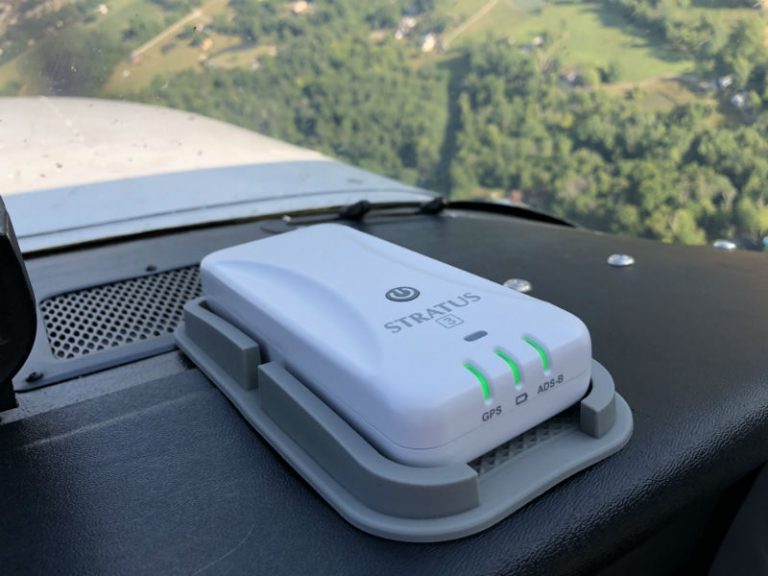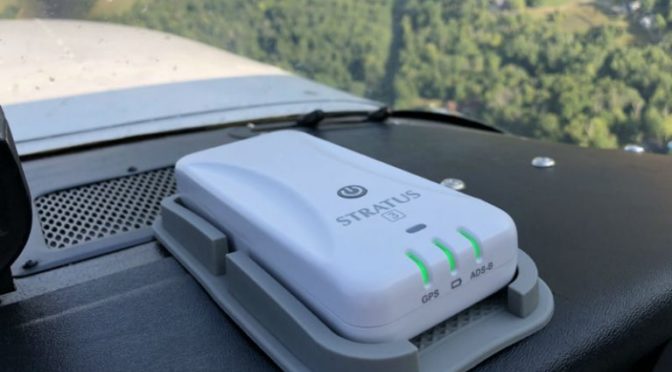

Portable weather receivers continue to be the most popular iPad accessory on the market. These all-in-one devices stream GPS position, subscription-free weather, ADS-B traffic and optional backup attitude information to your iPad, changing it from a static chart viewer to an interactive in-flight tool. Some even include SiriusXM weather and entertainment features.
They are also the source of a common question we get at iPad Pilot News: “which weather receiver should I buy?” With all the options (over a dozen at last count), it’s easy to get confused. Here, we’ll try to offer a practical guide to choosing the right ADS-B receiver. We’ll compare some of the most popular models.
One important note here – these ADS-B IN receivers are portable, non-certified units designed solely for the purpose of providing in-flight data to iPads, iPhones and other portable displays in the cockpit. They do not provide ADS-B OUT data and will not help you to meet the 2020 ADS-B mandate.
Choose the app first

The first tip is easy: choose the app you prefer first, then choose an ADS-B receiver that works with that app. Some pilots get this backwards, chasing hardware around and switching between apps. That just leads to confusion and frustration.
As a pilot, you have to live with your aviation app on every flight (and in between them) whether you use an ADS-B receiver or not. Make sure your app is one you understand and feel comfortable using. Whether it’s ForeFlight, Garmin Pilot, WingX, FlyQ or something else doesn’t matter – the right app is the one that works for you and your flying. Try them all (most offer free trials so you can couch fly them) and make sure you become truly proficient with the one you select. After picking your app, then it’s easier to choose the right ADS-B option.
Because of the deep integration required between app and accessory, some ADS-B receivers are app-specific:
- ForeFlight: Stratus 3, Scout, Sentry, Garmin GDL 50/51/52
- Garmin: Garmin GDL 50/51/52
- FltPlan Go: Stratus 3, Garmin GDL 50/51/52, Dual XGPS 170D, Dual XGPS 190
- WingX, FlyQ, Aerovie: Stratus 3, Dual XGPS 170D, Dual XGPS 190, iLevil 3SW, iLevil Astro
Don’t misunderstand us: there are differences between the various ADS-B receivers. But these differences pale in comparison to the apps. You have to start here.
Using a Garmin portable GPS?

If you fly with a Garmin 796, 696, aera 660 or aera 500 series GPS, there is an additional consideration. The GDL 50/51/52 can feed information to a portable GPS in addition to your iPad. This is a nice way to get extra utility out of an older GPS or to have a full-featured backup navigator in the cockpit.
For the 796 and aera 660, this connection is wireless via Bluetooth. For the other models, it requires an adapter cable. Also note the Garmin 796/795 and aera 660 allow you to display full pitch and roll information from the GDL 50/51/52’s built-in Attitude Heading Reference System (AHRS). This makes these truly no-compromise display units for the GDLs.
If you don’t have one of these devices, this feature won’t matter. If you have a Garmin GPS but you use another app, is it worth switching to take advantage of this? Only you can answer that question, but ask yourself which device would be primary: iPad or Garmin?
Comparing specs
Once you’ve settled on an app and considered the Garmin option, it’s time to choose a specific ADS-B receiver. This is where it makes sense to compare specs, but it’s worth noting that almost every receiver on the market offers the two key features: GPS and subscription-free weather. These are the things you’ll use most often, and almost every unit includes them (only the Scout lacks a GPS). That means there isn’t really a bad option.

Beyond these basics, there are a few other features to consider. One important one is an attitude heading reference system (AHRS). A weather receiver with a built-in AHRS can deliver backup attitude information or synthetic vision to your iPad. This is not a primary instrument, but in a worst case scenario, we would not hesitate to use it. For a VFR pilot, it may be overkill and you can save some money by choosing a non-AHRS model, but we still think there’s value in it for situational awareness. For an IFR pilot, it’s a great insurance policy.
- No AHRS: Scout, Dual XGPS 170D
- With AHRS: Stratus 3, Sentry, GDL 50/51/52, Dual XGPS 190, iLevil3 SW, iLevil Astro
Other considerations
Battery life is another feature to think about. For a homebuilder wiring in an ADS-B receiver, or for a pilot who plans to keep his receiver plugged into the cigarette lighter, a built-in battery may not be necessary – in fact, there are battery-free models you can choose. For a renter or a pilot who prefers fewer wires, a built-in battery is an essential feature. We also think it has great value as a backup. (If you need a portable battery pack for your receiver, this is our top pick.)
- No battery: Scout, Stratus 3i (panel-mount version of Stratus 3)
- With battery: Stratus 3 (8 hours), Sentry (12 hours), GDL 50 (8 hours), GDL 51 (7 hours), GDL 52 (5 hours), Dual XGPS 170D/190 (5 hours)

There are also some additional features beyond the basic ADS-B/weather/GPS/traffic/attitude set. Some models, like the Stratus 3, include automatic flight data recorders so you can store your flights and replay them in apps like CloudAhoy or Google Earth. The Sentry includes a carbon monoxide detector, helpful for alerting you to dangerous conditions (especially in winter).
The Garmin GDL 51 and 52, on the other hand, include a SiriusXM weather receiver for expanded signal coverage in and around the U.S. This also delivers additional weather features and satellite radio entertainment. It requires a subscription, but for no-compromise weather, it is a great option. The GDL 51 is a SiriusXM only receiver, while the GDL 52 is a combination SiriusXM and ADS-B receiver.
Finally, while most pilots spend a lot of time debating AHRS vs. no AHRS or SiriusXM vs. ADS-B, we think too little time is spent on “softer” features. These include ease of use, reliability and customer support. Such features aren’t easily compared in a chart, but they impact your flying in a significant way. Consider how well-integrated the receiver is with the app, how easy to use the entire system is and what customers are saying about support. You can learn a lot reading customer reviews online.
One feature that doesn’t matter much is reception. Every ADS-B receiver we’ve flown with has perfectly good reception for normal operations, and with the ADS-B network now complete, this is less of a problem than ever. Remember, one tower is enough in most cases – we usually see 5-10 towers at cruise altitude.
Comparison chart
To help you compare features side-by-side, we’ve compiled this chart to show most of the popular options. Click on the image for a larger image.
Build it yourself
There is another option for pilots who enjoy a little bit of electronics work. Stratux is an open-source software project that turns commercially available parts into full-featured ADS-B receivers. For about $150 in parts and a few hours of assembly, you can have a dual band receiver, and there are plenty of options to add GPS and AHRS. There are even some pre-built kits available, although not all include a battery so read the parts list carefully.
Final thoughts
Don’t make this decision harder than it needs to be. In its most basic form, we suggest a two step process. First choose your app, then choose whether you want “VFR features” or “IFR features.” The big difference between VFR and IFR would include a built-in AHRS, and perhaps SiriusXM Weather. In most cases, you will have a decision after answering those questions.
For more information, visit the links below.
- Stratus 3 – $699
- Sentry – $499
- Scout – $199
- Garmin GDL 50 – $699
- Garmin GDL 51 – $649
- Garmin GDL 52 – $1149
- Dual XGPS 170D – $499
- Dual XGPS 190 – $749
- iLevil3 SW – $1195
- iLevil Astro Link – $599
The post Which ADS-B or SiriusXM weather receiver should I buy? appeared first on iPad Pilot News.
Source: Ipad appsWhich ADS-B or SiriusXM weather receiver should I buy?

